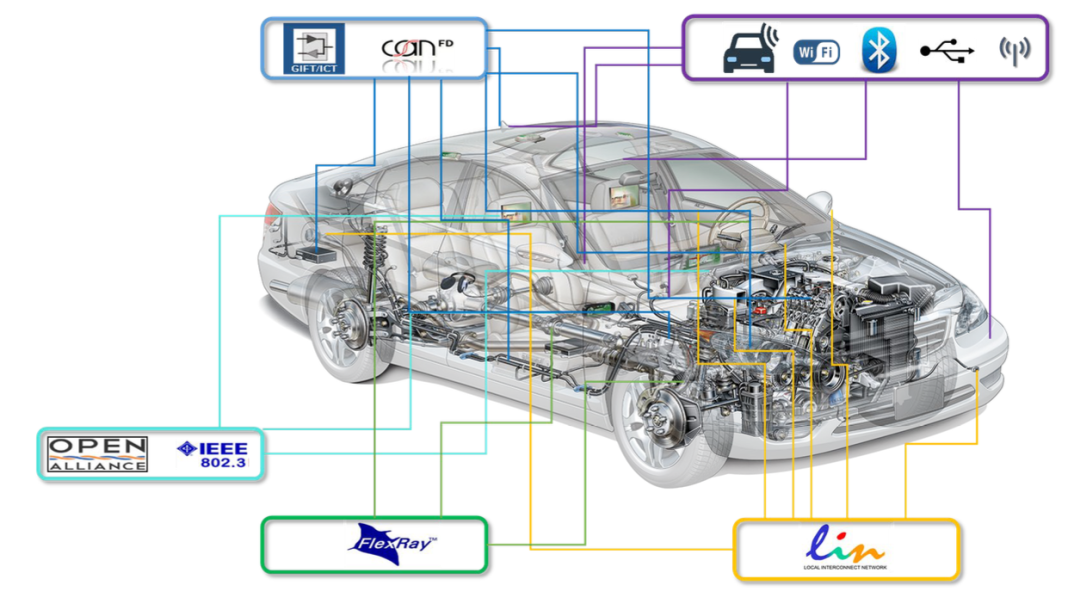onsemi:The latest trends in in-vehicle networking, these are must-know
Time:2024-07-17
Views:307
As vehicles become more advanced, helping to improve road safety, provide driver assistance features, and increase energy efficiency, the importance of their underlying technology increases. Whether it‘s a traditional internal combustion engine (ICE)-driven vehicle, a hybrid, or a pure electric vehicle, automotive designs include dozens of sensors, microcontrollers, and actuators, all of which generate or process large amounts of data.
The modern vehicle is more than just a means of transportation; it is an advanced computing platform on wheels. As with all computing systems, the ability to efficiently transfer data is critical to the smooth operation and safe operation of such systems.
Common In-Vehicle Network Technologies (IVN)
Electronics have been used in vehicles for decades, providing many useful features, often to enhance safety or entertainment. In the early days, many of these features stood on their own, neither providing data to other systems in the vehicle nor relying on data generated by other systems. However, as technology progressed and the benefits of integration became apparent, vehicle-specific networking technologies emerged.
Protocols commonly used in vehicles include LIN (Local Interconnect Network, LIN), CAN (Controller Area Network, CAN/CAN-FD), FlexRay, and MOST (Media Oriented System Transport, MOST). Transport, MOST). While each solution has its own unique characteristics and can meet different design considerations, more importantly, these existing technology solutions are struggling to meet the growing demands of modern vehicles.

The LIN bus is a cost-effective technology that is easy to implement and deploy for low data rate (<20kbps) application scenarios. However, its limited bandwidth and the fact that the number of system nodes is limited to 12 limits its value in modern vehicles.
CAN bus (and subsequent iterations such as CAN-FD) is widely used in vehicles and other safety-critical systems because it is very stable and reliable and relatively immune to electrical interference and noise. However, the limited bandwidth (typically around 2 Mbps) limits its use in certain data-intensive applications (such as infotainment systems and cameras), as well as the number of nodes. A new CAN-XL standard is currently under development to handle higher speeds and have the ability to interface with Ethernet, but for many engineers, a direct transition to an all-Ethernet solution looks more attractive.
The FlexRay bus offers precise timing and synchronization capabilities, making it suitable for time-critical applications such as drive-by-wire. However, complexity limits its popularity compared to other approaches.
MOST bus, which is only used for infotainment systems, has limited applicability and is costly, and has therefore been replaced by other solutions as the technology is phased out.
Ethernet is seen by many as an ideal alternative to the many existing solutions, providing high bandwidth and low latency communication capabilities. However, one problem with the current Ethernet protocol is its inherent Carrier Sense Multiple Access with Collision Detection (CSMA/CD) mechanism, which means that deterministic operation is not possible, making it unsuitable for use in any time-sensitive application scenario, such as line drives. For example, line drivers.
In addition, the cost of Ethernet technology is also an issue. However, given the huge potential of Ethernet, there are now deterministic protocols such as 10BASE-T1S, which incorporates Physical Layer Collision Avoidance (PLCA) mechanisms , providing the required performance for time-critical applications. In addition, the cost of automotive Ethernet equipment is rapidly declining, enabling more automakers to apply high-bandwidth features.
Ethernet continues to evolve, driven by organizations such as the OPEN Alliance, to meet the growing bandwidth demands of modern vehicles. New standards such as IEEE P802.3dh are enabling future fiber optic applications in vehicles to support demanding technologies such as low-latency 4K video and augmented reality.
Wireless protocols including Bluetooth®, Wi-Fi, and cellular communications are commonly used by drivers and passengers to connect their mobile devices. The primary need for wireless communications stems from the ability to perform certain functions, such as tire pressure monitoring (TPMS) and keyless entry (to name just two), where a wired connection cannot. However, with the development of ‘connected vehicle‘ (V2X) technology, which allows vehicles to communicate with other vehicles and their surroundings, the need for wireless communications has increased further, but with it the need for greater security.
Vehicle Architecture
With so many subsystems and sensors littering the interior of a vehicle, automakers must choose their vehicle architecture carefully. There are two main options - a domain architecture or a zone-controlled (zonal) architecture. Existing domain-based architectures combine parts with similar functions (e.g., drivetrain, chassis, and comfort) - although their locations may be scattered throughout the vehicle, which requires more wiring and adds weight and cost.
To avoid this problem, many automakers now prefer an area-control architecture approach, where subsystems are grouped together in close proximity despite their different functions. As a result, zones such as “right front,” “left rear,” etc. can be designated. While this approach reduces cabling requirements, it also increases the amount of data on the vehicle communications “backbone” between zones, thus requiring higher performance and bandwidth in the on-board network.
Typically, each zone is highly integrated with dedicated computing resources connected to the main CPU via a high-speed (and deterministic) communications backbone to support real-time applications such as advanced driver assistance systems (ADAS) and drive-by-wire. The use of a zone control architecture provides greater flexibility in integrating, removing or upgrading vehicle functions and features. It is easily scalable and adaptable to changing requirements.
While a zone control architecture has the potential to offer many benefits, its implementation can also lead to increased demands on the performance of the in-vehicle network. This is primarily due to the need for higher data traffic, low latency, redundancy, scalability support, and better security and diagnostic features.
Functional Safety
As vehicles become more automated, the need for functional safety and redundancy measures increases. More and more systems are required to comply with the higher ISO 26262 Automotive Safety Integrity Level (ASIL), and as drivers become more reliant on the decisions made and actions taken by the vehicle itself, safety level requirements are transitioning from Class A and B to the more stringent Class C and D components. Functional safety encompasses all aspects of design, from conceptualization to the final retirement of the vehicle.
It undoubtedly has a significant impact on the entire vehicle architecture as well as the on-board network. For high-performance ADAS functions such as automatic emergency braking and adaptive cruise control, low-latency data transmission is critical. Achieving functional safety compliance requires the deployment of redundancy in sensors and communication paths as well as sophisticated fault tolerance mechanisms.
While time-sensitive networks (TSNs) are required for all vehicle safety-critical functions, the shift to area-control architectures has enhanced this need. Precise tuning of timing and compensation for delays are critical to ensure the correct operation of ADAS functions, especially when components such as image sensors, LIDAR modules and electronic control systems are distributed in different areas of the vehicle. Even applications such as noise reduction using microphones in different areas require a TSN to work effectively. In terms of Ethernet solutions, existing TSN Ethernet protocols can be repurposed for automotive use.
For image sensor and camera interfaces, MIPI CSI-2 (Camera Serial Interface) and DSI-2 (Display Serial Interface) support high-speed data transfer and are ideal for transferring large amounts of data between camera systems, displays and infotainment systems. A standardized serial/deserial (SerDes) solution is being further developed by the Mobile Industry Processor Interface (MIPI) and the Automotive Serdes Alliance (ASA).
Eventually, ASA Motion Link Technology (ASA ML) will be approved for integration with MIPI CSI-2. Enhanced security of the MIPI protocol and asymmetric Ethernet (high bandwidth transmit, low bandwidth receive) for cameras are also being investigated in this collaboration.
ONSEMI‘s Role in In-Vehicle Networking (IVN)
ONSEMI has more than three decades of experience in in-vehicle networking, providing innovative products and best-in-class application support. The solution portfolio is currently based on many existing in-vehicle networking technologies, including LIN, CAN and FlexRay, with enhancements to the LIN and CAN products being released over the next few years, and little, if any, investment in FlexRay due to the lackluster growth expected for this protocol.
Clearly, 10BASE-T1S Ethernet will be a key area of focus for the automotive industry. ON Semiconductor has already launched its first products and is currently developing a second generation portfolio for this important protocol. With the majority of automakers expected to adopt area control architectures, 10BASE-T1S will be a fundamental part of future automotive communications. This is especially true for applications requiring high throughput, high bandwidth and high security, such as ADAS functions, including fully autonomous driving.
Despite the clear advantages of Ethernet in vehicle applications, existing protocols (e.g., LIN and CAN) will continue to be used in scenarios that do not require high communication rates (e.g., window opening, mirror folding, seat adjustment, etc.). However, we are already seeing Ethernet taking over some of CAN‘s market share, and it is expected that by next year, Ethernet will be the technology of choice for low-latency and high-bandwidth communications.
To summarize
Today, vehicle performance is no longer determined by the speed at which it travels, but more by the speed at which the in-vehicle network can transfer data in the “computing platform on wheels”.
While traditional protocols such as LIN and CAN will continue to play a limited role, some protocols such as MOST and FlexRay will be phased out. Regional control architectures will be preferred as they reduce the cost and weight of cabling, but will also require the application of TSNs and greater bandwidth, especially on inter-regional backbones.
Deterministic Ethernet (10BASE-T1S) will play an important role, becoming the default “go-to” technology for many automakers in the near future. Widespread adoption of this technology will drive increased standardization of in-vehicle networks and make possible the innovative solutions required for fully autonomous driving. In addition, only Ethernet solutions are currently available to advance the realization of improved vehicle safety and advanced autonomous driving systems.
ON has been playing an important role in automotive technology for decades, especially in in-vehicle networks. While LIN and CAN will continue to make progress on the device side, ON Semiconductor‘s main focus today is to develop a richer range of 10BASE-T1S Ethernet solutions to provide the automotive industry with the high-performance components needed to meet the next generation of automotive applications.









